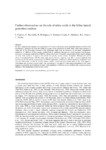Further observations on the role of nitric oxide in the feline lateral geniculate nucleus

Use this link to cite
http://hdl.handle.net/2183/14622Collections
- Investigación (FCS) [1293]
Metadata
Show full item recordTitle
Further observations on the role of nitric oxide in the feline lateral geniculate nucleusAuthor(s)
Date
1996-01Citation
Cudeiro J, Rivadulla C, Rodríguez R, Martínez-Conde S, Martínez L, Grieve KL, Acuña C. Further observations on the role of nitric oxide in the feline lateral geniculate nucleus. Eur J Neurosci. 1996;8:144-152.
Abstract
[Abstract] We have examined the responses of a population of 77 cells in the dorsal lateral geniculate nucleus (dLGN) of the anaesthetized, paralysed cat. Here the synthetic enzyme for the production of nitric oxide, nitric oxide synthase, is found only in the presynaptic terminals of the cholinergic input from the brainstem. In our hands, iontophoretic application of inhibitors of this enzyme resulted both in significant decreases in visual responses and decreased responses to exogenous application of NMDA, effects which were reversed by coapplication of the natural substrate for nitric oxide synthase, L-arginine, but not the biologically inactive isomer, D-arginine. Nitroprusside and S-nitroso-N-acetylpenicillamine (SNAP), nitric oxide donors, but not L-arginine, were able to increase markedly both spontaneous activity and the responsiveness to NMDA application. Furthermore, SNAP application facilitated visual responses. Responses of cells in animals without retinal, cortical and parabrachial input to the LGN suggest a postsynaptic site of action of nitric oxide. This modulation of the gain of visual signals transmitted to the cortex suggests a completely novel pathway for nitric oxide regulation of function, as yet described only in primary sensory thalamus of the mammalian central nervous system.
Keywords
Cat
Visual system
Neuromodulation
Parabrachial input
Visual system
Neuromodulation
Parabrachial input
Editor version
Rights
This is the peer reviewed version of the following article which has been published in final form at Wiley Online. This article may be used for non-commercial purposes in accordance with Wiley Terms and Conditions for self-archiving.





